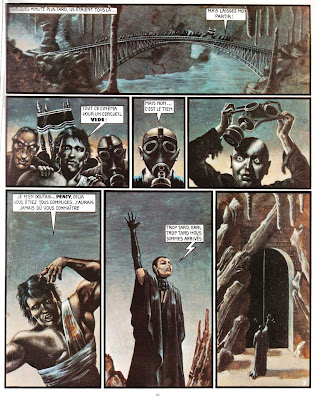Book Review: 'The Year's Best Fantasy Stories: 2' edited by Lin Carter

4 / 5 Stars
‘The
Year’s Best Fantasy Stories: 2’ (192 pp) was published by DAW Books
(No. 205) in August, 1986, and features cover art by George Barr.
I
got my copy way back in August, 1976, when I saw it on the shelves
among the other sf paperbacks at Gordon’s Cigar Store. At the time, I
found it to be one of the better DAW anthologies. Upon rereading it
nearly 40 years later, how does ‘Year’s Best Fantasy 2’ hold up ?
One
thing that has become quite clear over the intervening years is that in
1976, as far as publishers were concerned, the category of fantasy was
very much a sub-genre of sf. Most mass market paperbacks that dealt with
fantasy were either the Lord of the Rings trilogy, or ancillary titles
associated with that work. Aside from the LOTR, there might be some
barbarian adventure titles on the shelving, but that was pretty much it.
The idea that one day, much of the shelf space at major book retailers
would be devoted to fantasy, would have seemed …..well……. fantastical.
The
stories in ‘Year’s Best Fantasy 2’ all were first published in 1975,
and at that time, print outlets for such stories were few. Most of the
stories appeared in digest magazines like The Magazine of Fantasy and
Science Fiction, small press magazines like Anduril, or anthologies from
specialized publishers like Arkham House.
Most of the stories in
this anthology are as much horror stories as they are fantasy, a
reflection of the fact that in 1975, the genre was still centered on the
tropes inherited from the pulp era.
In his Introduction, editor Lin Carter commiserates over the failure of 'The Silmarillion', the fabled Tolkein epic perpetually In Preparation, to be released in 1975 (the book finally came out in 1977, and turned out to be remarkably dull).
Carter is encouraged by the bestseller status of Richard Adam’s 1975 fantasy novel 'Shardik' (which also was a colossal bore).
The stories:
The Demoness, by Tanith Lee: self-consciously overwritten, but entertaining, tale of a female vampire.
The Night of the Unicorn, by Thomas Burnett Swann: an allegory set in Mexico’s Acapulco region.
Cry
Wolf, by Pat McIntosh: Thula the warrior maiden meets a shadowy pair of
adventurers. A fast- moving, and effective, sword-and-sorcery tale.
Under the Thumbs of the Gods, by Fritz Leiber: unremarkable Fafhrd and Mouser story; our heroes mourn lost loves.
The
Guardian of the Vault, by Paul Spencer: a warrior is assigned a very
special guard duty. One of the better entries in the anthology.
The
Lamp from Atlantis, by L. Sprague de Camp: mild horror story about a
fabled talisman. Surprisingly well-written, for a piece of de Camp short
fiction.
Xiurhn, by Gary Myers: Lovecraft / Clark Ashton Smith
homage involving an outcast mage who seeks vengeance on his tribe.
Ponderous prose.
The City in the Jewel, by Lin Carter: as the
editor of the ‘Year’s Best Fantasy’ series, Carter had no real scruples
about promoting his own work. Sometimes his work was awful. But this
‘Thongor’ story, although employing a self-consciously ‘pulp’ –style
prose, is reasonably entertaining.
In ‘Ygiroth, by Walter C.
DeBill, Jr: Another Lovecraft-inspired tale about dark doings in ancient
lands. Competent, if not all that memorable.
The Scroll of
Morloc, by Clark Ashton Smith: this story was actually written by Lin
Carter, one of a number of putative Smith tales Carter fabricated from
plot scraps and titles from Smith’s posthumous belongings. The value of
churning out a Smith pastiche is questionable; readers should prepare to
encounter a remarkably constipated vocabulary, including words such as
‘jungle-girt’, ‘zenithal’ (pertaining to the zenith of astronomical
bodies), ‘antehuman’, ‘thaumaturgies’, ‘shamanry’, ‘desuetude’ (to fall
into disuse), and ‘protoanthropophagi’, among others.
Payment in
Kind, by C. A. Cador: the corrupt citizens of a desert city receive
their comeuppance. Another of the better entries in the anthology.
Milord
Sir Smiht, the English Wizard: a ‘Dr. Eszterhazy’ story about an
eccentric mage operating in Davidson’s proto-Steampunk version of late
18th century Central Europe. It relies on humor; unremarkable.
Summing up, ‘The Year’s Best Fantasy Stories: 2’ is one of the more rewarding volumes in the series. Well worth picking up.










































































